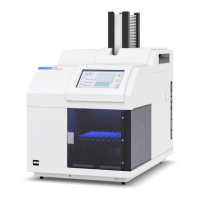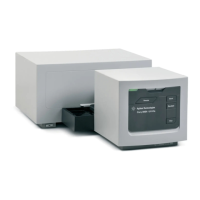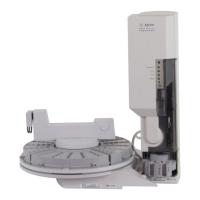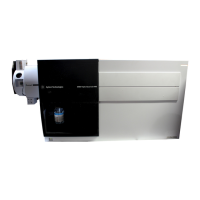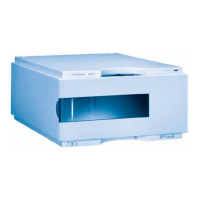11 Configuration
168 Operation Manual
To configure a single column
You define a capillary column by entering its length, diameter, and film thickness. You then
enter the device controlling the pressure at the Inlet (end of the column), the device controlling
the pressure at the column Outlet, and the Thermal zone that controls its temperature.
With this information, the instrument can calculate the flow through the column. This has great
advantages when using capillary columns because it becomes possible to:
• Enter split ratios directly and have the instrument calculate and set the appropriate flow
rates.
• Enter flow rate or head pressure or average linear velocity. The instrument calculates the
pressure needed to achieve the flow rate or velocity, sets that, and reports all three values.
• Perform splitless injections with no need to measure gas flows.
• Choose any column mode. If the column is not defined, your choices are limited and vary
depending on the inlet. Except for the simplest configurations, such as a column
connected to a specific inlet and detector, we recommend that you begin by making a
sketch of how the column will be connected.
To configure a capillary column:
1 Select Settings > Configuration > Columns.
2 Under Column Type, select Capillary.
3 Input the Length, Diameter, and Film Thickness into the appropriate fields.
If you do not know the column dimensions—they are usually supplied with the column—
or if you do not wish to use the GC calculating features, enter 0 for either Length or
Diameter. The column will be not defined.
Agilent recommends always defining capillary columns.
4 Under Inlet connection, select the desired inlet from the dropdown menu. Selections
include the installed GC inlets, and installed Aux and PCM channels.
5 Under Outlet connection, select the desired outlet from the dropdown menu.
• Available choices include the installed Aux and PCM channels, front and back detectors,
and MSD.
• When a detector is selected, the outlet end of the column is controlled at 0 psig for the
FID, TCD, FPD+, NPD, and ECD or vacuum for the MSD.
• If the column exhausts into a nonstandard detector or environment (neither ambient
pressure nor complete vacuum), select Other and enter the outlet pressure.
6 Under Thermal zone, select the desired thermal zone from the dropdown menu.
7 Set the Min Temp, Max Temp, and Max Program Temp for your column.
8 Set the column’s
• Manufacturer
• Date Manufactured
• Serial Number

